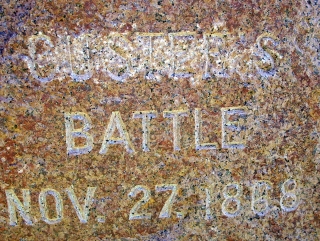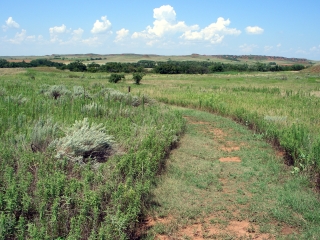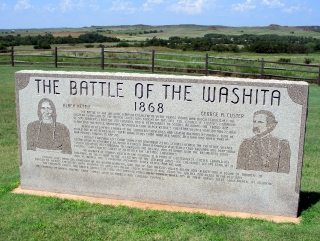NPS Website; Local Website
WHAT IS IT?
Site of the November 1868 battle between the U.S. Army and the Cheyenne Plains Indians.
 BEAUTY (3/10)
BEAUTY (3/10)Fields of tall grass, hordes of grasshoppers and stifling heat and humidity. Welcome to Oklahoma. In pictures, the sky looks wonderfully blue. In person it looks grey because the haze envelopes your eyesight.
A mowed path winds through the grasslands, turns up and around the anonymous field where fighting once occurred. We intended to walk the full 1½ miles worth of trails. Doesn’t sound like a lot? It is. The heat cut our journey in half.
HISTORICAL INTEREST (4/10)
Under the charge of Lt. Col. George S. Custer, the U.S. Army, in November 1868, attacked a peaceful village of Cheyenne Indians led by Black Kettle.
Four years prior, Black Kettle’s village at Sand Creek was attacked by Col. J.M. Chivington. Chivington’s U.S. Army forces slaughtered over 150 Cheyenne, mostly women, children and the elderly. Most American’s were outraged at the Army’s brutality especially when the massacreds’ mutilated body parts were placed on display in Denver.
Black Kettle had witnessed the absolute brutality but still signed peace treaties and moved his people to the Indian Territory. In 1867, Maj. Gen. Philip Sheridan received control of U.S. forces engaged in the western Indian Wars. He altered the Army’s tactics towards Total War. Nothing would be spared and all Indians, peaceful or not, were to be considered enemy combatants.
Black Kettle knew that a November attack was eminent. He fruitlessly pleaded to the U.S. government for protection. Despite the urging of his council, he did not move his people; he could not believe that the Army would break standard custom and attack during winter. He was wrong. At dawn, the morning following the council meeting, Custer attacked.
Black Kettle’s men were unprepared and largely unarmed. A Sand Creek-like massacre was narrowly avoided when Custer ordered his men to capture the women and children rather than kill them. Three nearby Cheyenne encampments were too far from Black Kettle to provide assistance. Gunfire took the lives of a reported 21 soldiers, 11 Cheyenne warriors, including Black Kettle and his wife, and 19 Cheyenne women and children. Over 50 Cheyenne were taken captive.
After the battle, Custer burned the Cheyenne’s supply of winter food as well as their shelter and clothing. He then ordered the Cheyenne women to gather the Indians’ 800 horses. The Army tried to slit the horses’ throats. When this tactic proved too slow, they shot the remaining horses. The battle convinced many Cheyenne to accept reservation life; the U.S. Army was very powerful and dedicated to Total War.
 CROWDS (6/10)
CROWDS (6/10)Just us at the battle site.
EASE OF USE/ACCESS (2/5)
The current Visitor Center is located in downtown Cheyenne, Okla. along U.S. Route 283. The Battlefield Site is about two miles west of town along Oklahoma Route 47A. Cheyenne, Okla. is about 30 miles north of Interstate 40, Exit #20 and 150 miles west of Oklahoma City.
CONCESSIONS/BOOKSTORE (3/5)
The Washita NHS has an interesting if sparse book selection. Included are eight George Custer biographies, five books about Black Kettle and the Washita fight, and six about the Sand Creek Massacre. The selections are thoughtful, but where is Bury My Heart at Wounded Knee? That book introduced most, including us, to the events at Washita. We think that the book choice will expand accordingly when the Site makes its planned move into a larger Visitor Center.
COSTS (4/5)
The Site is free. On weekends, Ranger-led tours of the battlefield take place at 9, 10, 11, 2, 3 and 4.
RANGER/GUIDE TO TOURIST RATIO (4/5)
The current Visitor Center doubles with the Park’s office. As soon as we opened the door, a few Rangers hopped out from behind their desks to help.
TOURS/CLASSES (7/10)
There is little space in the current Visitor Center for much more than a TV screen and a small viewing area in front the bookstore shelves. But what a TV screen it is! Flat-screen plasma 16:9 ratio; one of those TV’s that makes friends overwhelmingly jealous.
The intro video is not so bad either. The newly finished film approaches the battle with a wide frame of reference and sympathy for Black Kettle. Quibblers on both sides could find fault in some of the films conclusions but we applaud its understanding and presentation of both sides’ positions.
The film’s quality makes us want to give the exhibits that will be found at the new Visitor Center the benefit of the doubt.
 FUN (4/10)
FUN (4/10)Indian War fights, like the one that occurred at Washita, are not fun places. We commemorate Thomas Jefferson’s Louisiana Purchase, laud the exploits of Lewis and Clark, celebrate their bicentennial and praise their peaceful journey but forget that their history was only the beginning of our conquering of the American West.
Ugly and revolting things occurred. We cannot make any historical judgments about land ownership and rightful stake to property. That is far too complicated and ultimately irrelevant. Right and wrong, good and evil means nothing.
However, people were here first. The Army needed to remove the Indians forcibly from their land in order for the United States to grow. These brutal Indian Wars had to happen. These fights are just as important to our country’s success as the battles waged during most of our more acknowledged Wars.
Sites like Washita remind us that disturbing things happened to make this country ours. We are not an unwaveringly glorious people. Not everything done in our name elicits a prideful reaction.
WOULD WE RECOMMEND? (3/10)
We still cannot get the image of 800+ slaughtered horses out of our minds.
TOTAL 40/80
www.usa-c2c.com
© 2005